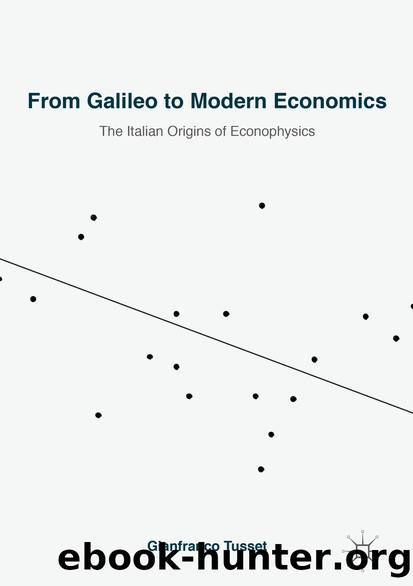From Galileo to Modern Economics by Gianfranco Tusset

Author:Gianfranco Tusset
Language: eng
Format: epub
ISBN: 9783319956121
Publisher: Springer International Publishing
The Social and Statistical Equilibrium of Aggregates
In 1994, Michio Morishima made the point that, on passing from economic equilibrium to social equilibrium (i.e. from individuals to aggregates), Pareto’s thought came closer to the concept of equilibrium in statistical physics (1994, p. xi). As we said, this could only hold if society were seen as a single, huge aggregate. The picture changes when we begin to consider many sublevels of organization (i.e. many groups), and Morishima added: “So it is not an easy thing to achieve a harmonious coexistence between these different equilibria” (ibid.). This is true not only when we consider economic and statistical equilibria, but also when we look at statistical and social equilibria.
For a start, as well as economic differences, the political circulation of élites is a necessary condition for heterogeneity, and also a consequence of it. Pareto followed the same path as in his analysis on the distribution of income: a political élite exists, and it includes only a small proportion of the population. The exercise of power, which no society can do without, relies on heterogeneity; and, when it comes to power, heterogeneity generates a hierarchy:Human societies cannot subsist without a hierarchy; but it would be a very grave mistake to conclude from this that they will be the more prosperous the more rigid is this hierarchy. (1906, chap. VII, sec. 103)
Download
This site does not store any files on its server. We only index and link to content provided by other sites. Please contact the content providers to delete copyright contents if any and email us, we'll remove relevant links or contents immediately.
International Integration of the Brazilian Economy by Elias C. Grivoyannis(86421)
The Radium Girls by Kate Moore(11865)
Turbulence by E. J. Noyes(7894)
Nudge - Improving Decisions about Health, Wealth, and Happiness by Thaler Sunstein(7458)
The Black Swan by Nassim Nicholas Taleb(6946)
Rich Dad Poor Dad by Robert T. Kiyosaki(6316)
Pioneering Portfolio Management by David F. Swensen(6168)
Man-made Catastrophes and Risk Information Concealment by Dmitry Chernov & Didier Sornette(5877)
Zero to One by Peter Thiel(5637)
Secrecy World by Jake Bernstein(4593)
Millionaire: The Philanderer, Gambler, and Duelist Who Invented Modern Finance by Janet Gleeson(4299)
Skin in the Game by Nassim Nicholas Taleb(4122)
The Age of Surveillance Capitalism by Shoshana Zuboff(4116)
The Money Culture by Michael Lewis(4025)
Bullshit Jobs by David Graeber(3991)
Skin in the Game: Hidden Asymmetries in Daily Life by Nassim Nicholas Taleb(3867)
The Dhandho Investor by Mohnish Pabrai(3635)
The Wisdom of Finance by Mihir Desai(3605)
Blockchain Basics by Daniel Drescher(3429)
